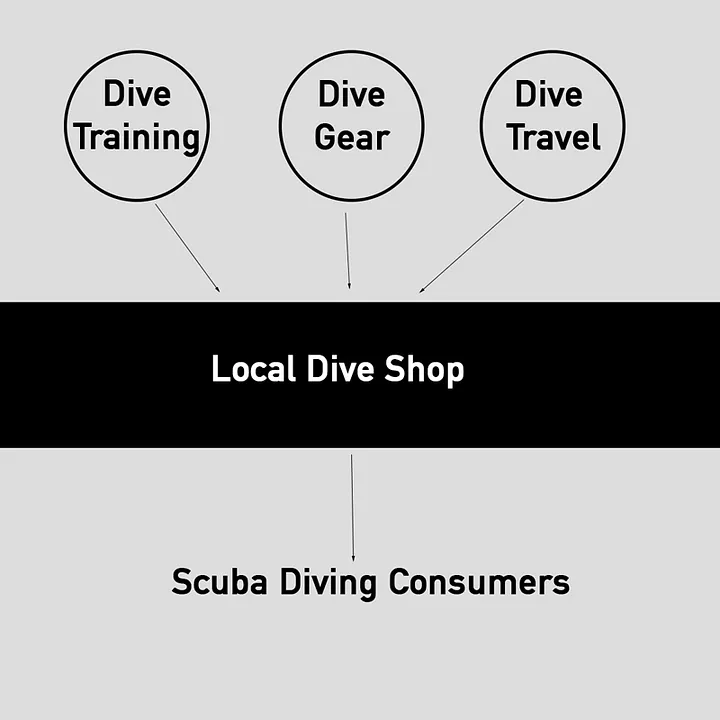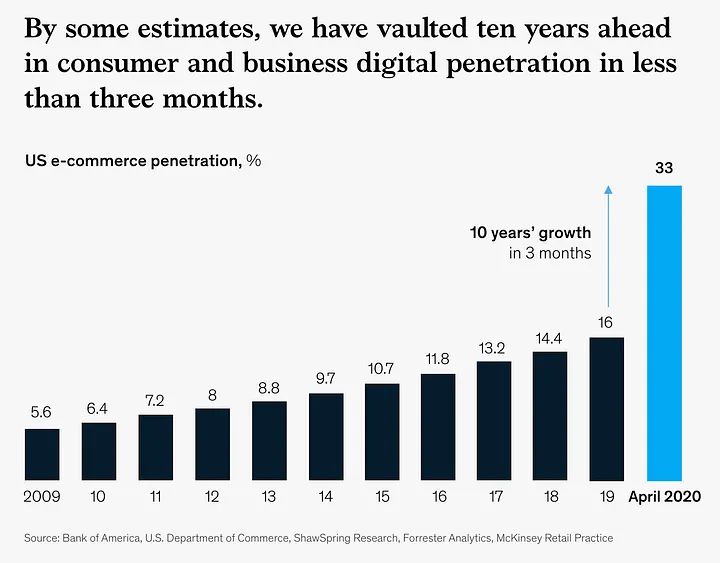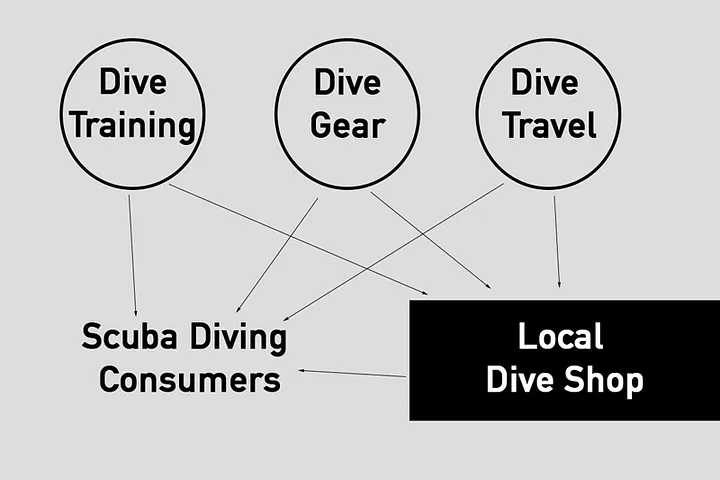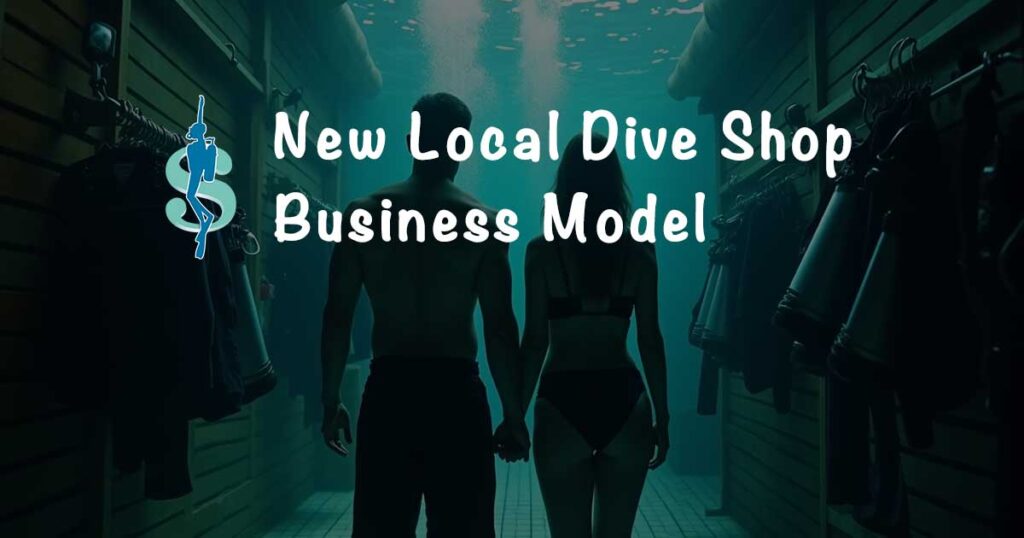A New Business Model for a Redefined Local Dive Center
The retail, education, and travel industries are going through a severe transformation, and the scuba diving industry operates in all three of them.
Retail, education, and travel industries are going through a severe transformation that started before the coronavirus pandemic, and the scuba diving industry operates in all three of them. But the speed of change has accelerated in a COVID-19 world, and we need to keep up — or better yet, get ahead of the curve.
The dive industry has been resisting changes to its business model for decades but can no longer withstand a tsunami of changing customers’ expectations and behavior.
I will look at the historical ‘distribution channel’ used to provide scuba diving lessons, dive equipment, and scuba diving travel to scuba diving consumers. Then, I’ll look at how it is changing and how the coronavirus pandemic accelerated this evolution.
Finally, I’ll look at what it means for your scuba diving business.
This post is part of our Shifting Tides: Dive Industry Assessment & Strategies for Today’s Scuba Divers series by the Business of Diving Institute and Darcy Kieran, author of:
Table of Contents
Traditional Distribution Process for Scuba Diving Products & Services
Historically, dive gear and scuba lessons have been provided to the consumer by ‘local dive shops’ (in ‘origin’ dive centers) and ‘dive resorts’ (in dive destinations). And way back then, dive travel was mainly sold by local dive shops.
We’re talking, here, pre and early-internet. Yet, to this day, the dive industry business model has barely changed. Consumers have changed, but not the scuba diving industry.
Bear with me for a minute.
Pre-internet, it was difficult for a newly certified scuba diver to independently select the best dive destinations for his/her annual vacations. The dive instructor in the local dive shop was the principal source of information. Scuba divers would come to the local dive center to check pictures of earlier trips to various scuba diving destinations. And group travel was arranged by the dive instructor.
It looked like this.

Dive gear manufacturers, scuba diving training agencies, and dive resorts (dive destinations) were relying on local dive shops to reach consumers.
The local dive shop was both ‘the front line’ and the gatekeeper. It is no more!
This model doesn’t work anymore, and it became even more apparent post-COVID-19.
Just like eLearning is now part of everyday life, eCommerce is now more accepted than ever before — even expected. The dive industry can’t continue to ignore this new world.
Noticeable Dive Industry Trends
I will be looking at ‘trends’ but only as it relates to the distribution channels used to reach scuba diving consumers.
Trends in Dive Travel
Dive travel was the first scuba diving industry sector to bypass the local dive shop significantly. Knowledge about dive destinations is now available to all, on the internet — with much more in-depth knowledge than what the local dive instructor can provide.
A local dive professional can’t be knowledgeable about every dive destination in the world. In that sense, the internet is providing more value to scuba divers. And ‘providing value’ is vital for a business to be sustainable.
The next dive industry segment to bypass the local dive shop (in ‘origin’ locations) is scuba diving training.
Trends in Scuba Diving Training
Initially, online education (eLearning) was introduced as a means to let dive instructors do what they love best — be in the water — while the ‘boring’ part of teaching in-class could be done at home ‘in the comfort of your pink slippers.’
eLearning also created an additional way to bypass the local dive shop. It is quite simple and convenient for a client-diver to proceed with the ‘dive theory’ part of learning to scuba dive at home — or at work! And, then, you fly to your dream vacation destination where you will go underwater with a dive instructor, first in a pool, then in the magical ocean.
I do not believe this provides the best value to the consumer. You end up with rushed ‘confined-water’ (pool) training sessions because there are just so many more exciting things to do under sunny tropical skies! Cutting corners is no way to revert our excessive dropout rate.
Only 40.8% of divers who did their open water certification dives in a tourist destination felt ready at the end of their course compared to 54.8% of people who did it close to home. (Have a look at the other results from our survey on whether people were ready to dive after their open water scuba certification course.)
But it is challenging to explain to future scuba divers that it is more valuable to them (in the long run) to be learning to dive at their local dive center before going on vacation. Therefore, the trend toward going to a dive resort after eLearning is continuing to grow.
With COVID-19, learning online instead of in-person has become the norm rather than the exception. Consumers are much more receptive and used to it, by now. The coronavirus pandemic has accelerated the trend toward eLearning.
Within the dive industry, we’ve seen training agencies rushing to launch new online learning programs — about anything and everything.
This eLearning trend is here to stay, and it means that it is becoming even easier to bypass the local dive shop.
“The shift of learning from outside the home to inside has blurred the lines between learning and leisure.” Source: McKinsey & Company
To counteract this trend, local dive shops would need to reach local consumers while they are researching ‘scuba diving in Fiji’ or ‘PADI certification in Cozumel.’ Even with an unlimited online marketing budget, this would be a tough challenge. And local dive shops barely have any marketing budget! It’s another reason why we need a worldwide trustworthy experience brand for scuba diving.
Trends in Scuba Gear Distribution
This was the last leg on which local dive shops could still hope to stand. And there would be a lot to say about this! But I will move as quickly as possible to get to the part of discussing ‘what to do about these trends.’
Selling scuba diving equipment is the way most local dive shops have kept the lights on. The cycle of extracting money from clients in a local dive shop has, for the most part, been in this order:
- get them in the dive shop with cheap scuba lessons,
- sell them overpriced dive gear, and
- book them on a dive trip to sell them more courses and equipment.
With the beginning (training) and the end (diving) of this cycle bypassing the local dive shop, it is making it hard for local dive shops to keep their lights on! Scuba divers going straight to the dive resort are often not even aware of the existence of a local dive shop.
And that’s only one trend.
Another significant trend with dive gear has been a reduction in “sales per diver.” New scuba divers tend to buy less scuba equipment than their male baby boomer predecessors.
Otherwise, a crucial development in retailing, of course, is eCommerce. That’s another trend we’ve seen surging during the worldwide pandemic. If you are not convinced, look at this graph from McKinsey & Company, a renowned US-based management consulting firm that advises on strategic management to corporations and governments.

“By some estimates, we have vaulted 10 years ahead in consumer and business digital penetration in less than 3 months.” (McKinsey & Company, The Reinvention of Retail)
Let that sink in for a minute!
Why has eCommerce been so slow at being implemented in the dive industry?
There are numerous reasons why eCommerce has been slow at penetrating the scuba diving industry.
For one, dive industry leaders have continued to maintain that the local dive shop was, and ought to, remain the focal point of the industry. This is based more on nostalgia than on sound business principles.
Can local dive shops operate an eCommerce site in a way that will satisfy today’s consumers? No. It would require an investment far superior to what a local dive shop owner could afford.
“Aside from value, convenience and availability are most often cited as top drivers of consumers’ decisions about where to shop.” ~McKinsey & Company
When shopping online, consumers expect speed, availability, and convenience. Delivery has to be tomorrow, or earlier! Scuba diving equipment websites should have all models in all sizes and all colors. Consumers expect everything to be available. Our internal dive industry distribution issues are none of their concern! On this front, as for dive travel, the internet is providing more immediate value to the scuba diving consumer than the local dive shop with its limited inventory and product knowledge.
By pretending that local dive shops were able to continue to satisfy evolving consumers with a small, undercapitalized store, the dive industry has simply delayed the inevitable.
‘Direct to consumer’ is how most dive gear manufacturers will try to offset a reduction in scuba gear sales in local dive shops. You can’t blame dive gear manufacturers for bypassing local dive shops — they were the last to do it after scuba diving certification and dive travel agencies.
However, this is really just a plaster for the wounded dive gear industry. A complete redesign of our business model needs to bring the experience of scuba diving at the forefront with equipment sales tagging along with a distribution system bringing gear to where it is needed: at the dive site, not in a small downtown dive retail store.
Current Distribution Process for Scuba Diving Products & Services
This is how the dive industry distribution process looks like nowadays. It was already heading in that direction. COVID-19 merely made it happen faster.

The local dive shop in an origin market is no longer a required component of the value chain.
It’s messier but… It is what it is!
The local dive shop is no longer ‘key’ in reaching scuba diving consumers, and it is facing an existential challenge: What is the new raison d’être of the local dive center? It must bring significant value to scuba divers for them to do a “detour” to get to it.
A Redefined Local Dive Center
First, let’s address the elephant in the room.
I can hear you yelling at me through your smartphone screen! “Local dive shops are crucial for the diving community. They provide air fills as well as access and information on local dive sites.”
Yes. I know.
In fact, the coronavirus pandemic contributed to making local dive shops more of a dive destination than merely an ‘originator’ of clients for dive resorts in the tropics. But here’s the thing… That’s about scuba diving (the activity), not selling gear.
Local ‘dive centers’ can still bring value to scuba diving consumers. Dive ‘shops’ provide very little value nowadays.
Shaming people into buying dive gear from us because we are providing air fills was always a non-sustainable business scheme, and it is now utterly disconnected from reality.
A local dive shop sells six different products and services to scuba divers:
- Education / Training
- Equipment / Toys
- Experience / Travel (the activity of scuba diving)
- Rental Dive Gear
- Repair and Maintenance
- Refills
The first 3 are the big ones. They are known as the 3Es (PADI) or the 3 Ts (Business of Diving Institute).
We’ve already discussed them in this article. These products and services no longer need the local dive shop to reach end-users. And in many cases, scuba diving consumers find more value when shopping outside the local dive shop. ‘Value’ includes convenience, product knowledge, and availability.
We need to face reality: the 3 Es (or 3 Ts) are bypassing local dive shops, and that trend is intensifying.
So, now what?
You can only swim against the current for so long!
The way to be successful in any business is by bringing value to consumers. And that could be in the last three services listed above: Rental dive gear, repair & maintenance, and refills. These services can more hardly be remotely provided.
It is conceivable and seemingly better in the long run, that repair & maintenance, and rental gear be provided from a centralized and remote location. But for now, these are services for which scuba divers may directly benefit from your local services.
In other words, the local dive shop should drop the word ‘shop’ and work on being a quality ‘dive center’.
Find a location near an appropriate local dive site. Set up a fill station for air, nitrox, and possibly trimix. Maintain quality rental dive gear to be used at that dive site by scuba divers and dive instructors.
That is the definition of a ‘local’ business.
I bet you’ll find that your profitability may even go up! Maintaining a retail store can be expensive.
At that new dive center location, the focus is on scuba diving. That’s why you want to be near a proper local dive site. You may also select a pool as your location, especially if it’s deep enough for scuba divers to practice their skills outside of scuba lessons.
Of course, you may offer scuba diving lessons at that location, but the focus has to be on doing the activity of ‘scuba diving’. The rest is just there to support the activity. This is actually a paradigm shift that we discussed extensively at a DEMA Show in Orlando, Florida.
Operating under this new business model requires that each of these services be profitable in itself. You can no longer rely on selling overpriced dive gear to subsidize the rest of your operations. It is not sustainable. It is preventing evolution in the dive industry.
An even more ‘out of the box’ business model would involve tankless diving, where we no longer have to worry about the proximity of a fill station.
Promotional & Visibility Issue
I know the owner of a local dive shop in an urban area who transformed his local dive shop business into such a dive center, dropping the in-store retailing of dive gear. His total revenues went down, but profits went up. And his happiness also went up! He joined the dive industry because he enjoys scuba diving, not managing a retail store.
The first problem you will encounter if you proceed like him is with dive training agencies and scuba gear manufacturers.
To be listed on their website as a retailer or training center, you must be operating a store. Scuba diving training agencies and dive gear manufacturers are forcing us to maintain this non-sustainable model of a ‘local dive shop’ operating 6 businesses under one roof.
So… The h*** with them!
Your main source of new clients is likely to be Google and word of mouth, not the old dive training agency website.
Word of mouth and good reviews will be easier to get if you concentrate your energy, money, and time on providing what you are good at, instead of trying to be everything to everybody. You got into diving because you love diving. Focus on that! That’s how you will be able to offer consistency in the quality of the experience under your personal craft brand.
This is how you can plan to make a good living out of your passion for scuba diving.
Furthermore, soon, the most significant part of your revenues should come from repeat business because your focus shifted to the adventure of scuba diving with your business model based on people diving locally. It is no longer based on quickly churning new entry-level scuba diving certifications to please the PADI and SSI of this world.
Otherwise, Google is not like your dive training agency. You do not need to operate a retail store to be listed as a business on Google Maps. The same principle applies to Facebook. Take advantage of that! They matter much more than the dive training agency websites.
It will be good for you — and for the dive industry.
It’s always been ridiculous that consumers searching how to ‘learn to dive’ on Google were being directed to ‘retail stores’ selling gear, while the actual locations to take the scuba lessons were often miles (kilometers) from there!
This is a business opportunity for your local diving business, and it can be an exciting transformational time for the scuba diving industry.
A Future Scuba Diving Brand Based on The Quality of The Experience
The scuba diving industry is lacking a reliable worldwide brand. Scuba diving is a global activity, no matter where you live. And the experience you encounter under Brand A in dive destination X is usually totally different than the experience you discover under the same Brand A in dive destination Y. Check the results of one of our surveys on this topic.
Since scuba diving is an activity where safety matters, scuba diving consumers need to have ‘trust’ in the quality of the experience they will encounter, everywhere they go.
Eventually, we will see a scuba diving brand establishing itself as a provider of a consistent scuba diving experience at all locations operating under that brand name. The focus will be on the consistency of the quality of the activity of scuba diving.
Keep an eye out! That is the brand under which you would want your reborn ‘local dive center’ to be operating – or contact me so we work on it together.
Further Discussions About the Dive Industry Business Model
- Strategy: Redesigning The Scuba Diving Industry Business Model: If we’re constantly competing but not growing, it’s time we make a move!
- Don’t Blame The Internet! The Traditional Dive Shop Business Model Was Dead Before That. 8 Challenges & 6 Elements of Solution for a Scuba Diving Industry in Tune With Today’s Consumers
Continue reading about Shifting Tides: Scuba Diving Industry Assessment & Strategies for Today’s Scuba Divers.
If you found the information on this page valuable, would you consider buying me a coffee?
Either way, let’s work together on “raising the bar” in the dive industry to satisfy today’s consumers!
Your Dive Industry Compass
Scuba Diving Market Research, Surveys, Reports & Statistics
Shifting Tides
Strategies for Today’s Scuba Divers
Living The Scuba Dream
Plan Your Scuba Instructor Career & Deep Dive the Plan
You may also be interested in The Immersion Zone (our podcast), Scubanomics (our newsletter for dive professionals), and our published books & reference guides.





